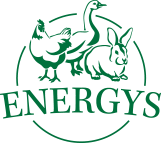Rabbits
Poultry
Laying hens
Quails
Guinea pigs
Pigs
Ostriches
Sheep and goats
Pigeons
Pheasants
Forest animals
Chicken Breeds and Hybrids
Breeders raising hens for egg production naturally want them to produce as many eggs as possible while keeping costs low. For this purpose, commercial breeders exclusively use specially-bred hybrid layer hens created by crossing different genetic lines of pure breeds. These hybrid breeds carry in their genetic information the desired traits such as a high number of laid eggs, good shell, egg size, etc. On the other hand hobby breeders (small breeders) typically focus on purebreds, not only for their utility, but also for their ornamental and therapeutic uses. Some sources claim that there are around two hundred breeds of chickens, all descended from wild Asian birds.
Hybrid layer hens used in commercial operations
In terms of final hybrids of layer hens, professional farms typically use the Lohmann Brown, Lohmann White, Bovans Brown, Dekalb White and ISA Brown breeds. If the recommendations of breeding companies concerning the right conditions are followed (i.e. nutrition, temperature and humidity, light regime, stable emissions, etc.), layer hens can be expected to lay around 350–450 eggs per laying cycle. A cycle typically lasts 50 to 80 weeks.
Breeds of chickens used by small operations
Targeted breeding has resulted in a large number of chicken breeds that produce fewer eggs than commercially used hybrids, but can still raise chicks, are more resilient to environmental conditions and less demanding in terms of feeding, have an attractive appearance, etc.
According to the 2006 poultry breed catalogue, there are 144 breeds of domestic chicken being raised in the Czech Republic, including 75 breeds of dwarf and bantam chickens.
The basic division of breeds is as follows:
Layer breeds are light, temperamental chickens weighing up to two kilograms. The typical representatives of this type are Leghorns, German Leghorns and the Czech Gold Brindled Hen.
Medium breeds have a combined use – they are good layers and are also well muscled. Compared to layer breeds, they reach maturity later and are heavier – hens between 2 and 2.5 kg, roosters up to 3.5 kg. This group includes the Rhode Island Red and the Hampshire, Sussex, Plymouth, Welsummer and Amrock breeds.
Heavy breeds are characterised by a large body and a weight from 3.5 to 5 kg. These include the Brahma, Cochin, German Langshan and Orpington chickens.
There are also fighting breeds raised for cockfighting, which are very muscular. These include the Cornish, Asil and Malay Game breeds, as well as fighters (Indian Game, Shamo, Ko Shamo, Madras, New England). There is also the Ayam Cemani breed from Indonesia, specifically the village of Cemani near Surakata on the island of Java. Because of a genetic mutation called fibromelanosis, the chicken looks like it flew through a chimney. Its feathers and skin are all black, and if you tried to cook it, you would find that its meat and internal organs are also tainted black. Their egg shells, however, have the usual cream colour.
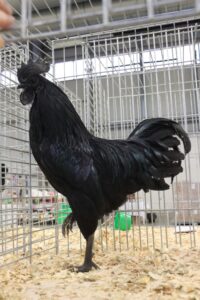
Breeds with special traits are mainly raised for their attractive appearance, with distinctive plumes or beards and feather textures. For example the “silky” texture is created by feathers with soft stems and unconnected barbs. Special trait breeds include the Araucana, Padovana, Polish, Naked Neck, Phoenix and Silkie chickens.
Bantam and dwarf breeds were bred from most of the basic breeds, and differ with their small body frame and low weight. Common dwarf breeds include Welsummer, German Leghorn, Plymouth and Wyandotte chickens; frequently encountered bantam breeds include Sebright chickens, the Barbu d’Anvers and the Booted Bantam.
A separate group is national chicken breeds. In addition to the only original Czech breed, the Czech Gold Brindled Hen, the National Programme for Protecting and Utilising Genetic Resources of Livestock includes nineteen lines of layer hybrid hens from the recognised breeds Moravia, Dominant and Horal. These layer hybrids were created for the purposes of small operations. They are highly tolerant of local climatic conditions while maintaining a relatively high production of eggs, are easy to feed and have a calm disposition. There are many variants with different feather or shell colours.
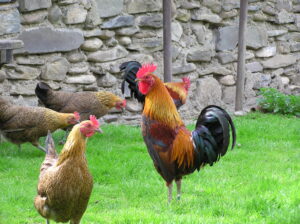
Related products
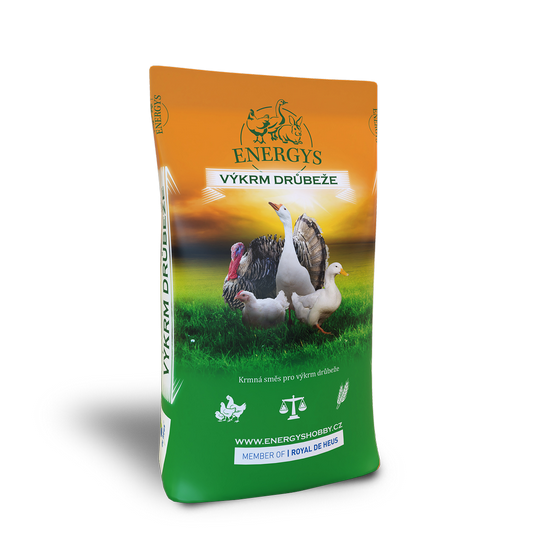
POULTRY UNI 30
A mashed concentrate for fattening of all categories of poultry, which includes the highest quality soja. It is mixed with cereals in a ratio of 20-40% (by type or phase of fattening). It contributes to fast growth and a high meat content. It does not contain coccidiostats.
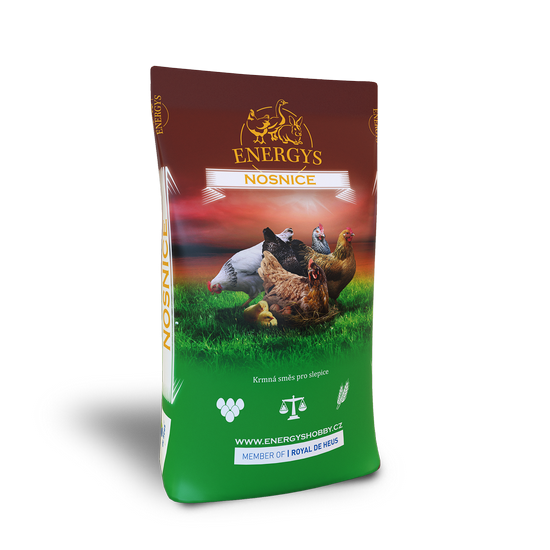
LAYER REPRO
Granulated feed for laying hen breeds. Supports higher hatching rates and the successful development of the embryo. Higher content of chosen substances). The laying hen must have access to an adequate amount of potable water.

LAYER GOLD
Granulated feed for laying hens when laying. Supports high laying eggs with a solid shell and a beautiful yolk color. It follows the feeding of the Chicken MIDI mixture. Indicative feed consumption per 1 year ranges from 50-60 kg / piece.

LAYER KLASIK
A powered feeding mix intended for laying hens. With its rough shredded structure it contributes to maximum usability.

CHICKEN MIDI
From the 5th week to the end of the 20 week old chickens. It follows on from feeding with the Chicken MINI feed. Through its make up it helps in the correct development of the organism and with future high usability. It doesn’t contain coccidiostats. It is produced in two forms, granulated and powder.

CHICKEN MINI
A crumbled compound feed without anti-coccidiosides. Suitable for reared chickens of the laying hen type till the end of their 4 weeks of age. It contains a balanced ratio of nutrients supporting the correct development of chickens. For weaning chickens the following mix is CHICKEN MIDI.
